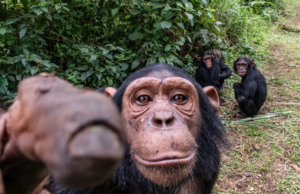Planet of the Apes and Image Rights
posted in
17
May
2012
 When a TV crew goes to GAP Sanctuary Sorocaba to record the lives of the guests and interview us about the project, we have to sign, for us and for the chimpanzees, a document of allowance of image rights. In our case, there is no cost. However, it could be charged.
When a TV crew goes to GAP Sanctuary Sorocaba to record the lives of the guests and interview us about the project, we have to sign, for us and for the chimpanzees, a document of allowance of image rights. In our case, there is no cost. However, it could be charged.
The book “Planete des Singes (Planet of the Apes)” was first published in France in 1963 by writer Pierre Boulle. At that same year, North American producer Arthur Q. Jacobs bought the rights of the book to convert it into a movie. Five years later – in 1968 – "Planet of the Apes" begins to be exhibited in U.S. theaters and all over the world, and becomes a success.
The film turned out to be a series: in 1970 it was released the second – "Back to the Planet of the Apes." A year later, in 1971, the third – "Escape from the Planet of the Apes." In 1972 comes the fourth film – "Conquest of the Planet of the Apes." In 1973, the fifth – "Battle for the Planet of the Apes."
In 1974, CBS produced 14 episodes of a series of Planet of the Apes for television. In 1975 it comes in an animated series entitled "Back to the Planet of the Apes."
In 1998, with the 30th anniversary of the first movie, American Movie Classics produced the two-hour documentary “Behind the Planet of the Apes”, which celebrates all the movies released and their protagonists.
In 2011, the film "Rise of the Planet of the Apes" is released in theaters worldwide, raising until now an amount close to $ 500 million – the cost to produce the film did not reach $ 100 million. A continuation of this movie is already in production to be launched on 2014, following the same scheme of the film 2011.
On April 2012, Disney released the movie Chimpanzee, which rose in the first week of exhibition $ 10 million in United States. This movie shows, for the first time, real chimps in the wild at Taï Forest, Ivory Coast, as the protagonists.
How much chimpanzees, as individuals, had won with these movies, which enriched studios, producers, directors and actors? Practically nothing. The movies helped, of course, to show their intelligence and sensibility, and everything they suffer submitted to humans hands.
We would like to present a question to all those who are involved in the production of films about the great apes: wouldn’t it be fair, based on the concept of Image Rights, that they received, at least, 1% of the amount raised with these movies?
Chimpanzees have basic rights in our societies, and many countries have already approved laws or at least recognize that they cannot be sold, euthanized, tortured or abused in any kind of human action. Why, then, not charge for the exhibition of their images, their lives, their society, so this value could be reverted to the care and technical work necessary for the species to survive?
There are more than 20 sanctuaries affiliated to PASA – Pan African Sanctuaries Alliance – in Africa and a few others in Indonesia, to protect orangutans. They exist precariously, with lack of funds and demand for jobs that cannot be met. The amount of 1% of the Image Rights could be used for the maintenance of these sanctuaries and would be reason of pride to all people involved in these productions.
GRASP Project, of United Nations – which aims to protect the great apes all over the world – could be the custodian and administrator of this fund, to give a full guarantee of its proper use.
Undoubtedly, the people who goes to the movies and collaborate for the raising of billionaire box offices in the last 40 years would be glad to know that their money is helping their primitive brothers, who are struggling desperately to survive in the last frontiers of the Planet.
Dr. Pedro Ynterian
President, GAP Project International

 Español
Español
 Português
Português








